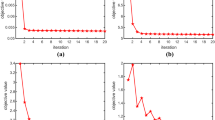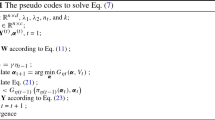Abstract
For many machine learning and data mining tasks in the information explosion environment, one is often confronted with very high dimensional heterogeneous data. Demands for new methods to select discrimination and valuable features that are beneficial to classification and cluster have increased. In this paper, we propose a novel feature selection method to jointly map original data from input space to kernel space and conduct both subspace learning (via locality preserving projection) and feature selection (via a sparsity constraint). Specifically, the nonlinear relationship between data is explored adequately through mapping data from original low-dimensional space to kernel space. Meanwhile, the subspace learning technique is leveraged to preserve available information of local structure in ambient space. Last, by restricting the sparsity of the coefficient matrix, the weight of some features is 0. As a result, we eliminate redundant and irrelevant features and thus make our method select informative and distinguishing features. By comparing our proposed method with some state-of-the-art methods, the experimental results demonstrate that the proposed method outperformed the comparisons in terms of clustering task.



Similar content being viewed by others
References
Alamri AA (2011) Theory and methodology on the global optimal solution to a general reverse logistics inventory model for deteriorating items and time-varying rates. Comput Ind Eng 60(2):236–247
Baudat G, Anouar F (2000) Generalized discriminant analysis using a kernel approach. Neural Comput 12(10):2385–2404
Baudat G, Anouar F (2003) Feature vector selection and projection using kernels. Neurocomputing 55(1):21–38
Cai D, Zhang C, He X (2010) Unsupervised feature selection for multi-cluster data. In: ACM SIGKDD international conference on knowledge discovery and data mining, pp 333–342
Cao B, Shen D, Sun JT, Yang Q, Chen Z (2007) Feature selection in a kernel space. In: Proceedings of the twenty-fourth international conference on machine learning, pp 121–128
Gao L, Guo Z, Zhang H, Xu X, Shen HT (2017) Video captioning with attention-based LSTM and semantic consistency. IEEE Trans Multimedia 19 (9):2045–2055
Gu Q, Li Z, Han J (2011) Linear discriminant dimensionality reduction. In: Joint European conference on machine learning and knowledge discovery in databases, pp 549–564
He X (2005) Locality preserving projections. University of Chicago
Hou C, Nie F, Li X, Yi D, Wu Y (2014) Joint embedding learning and sparse regression: a framework for unsupervised feature selection. IEEE Trans Cybern 44(6):793–804
Hu R, Zhu X, Cheng D, He W, Yan Y, Song J, Zhang S (2017) Graph self-representation method for unsupervised feature selection. Neurocomputing 220:130–137
Lai H, Pan Y, Liu C, Lin L, Wu J (2013) Sparse learning-to-rank via an efficient primal-dual algorithm. IEEE Trans Comput 62(6):1221–1233
Lei C, Zhu X (2018) Unsupervised feature selection via local structure learning and sparse learning. Multimedia Tools Appl 77(22):29,605–29,622
Nie F, Huang H, Cai X, Ding CHQ (2010) Efficient and robust feature selection via joint ?2,1-norms minimization. In: Advances in neural information processing systems 23: 24th annual conference on neural information processing systems 2010. Proceedings of a meeting held 6-9 December 2010, Vancouver, British Columbia, Canada, pp 1813–1821
Nie F, Zhu W, Li X (2016) Unsupervised feature selection with structured graph optimization. In: Proceedings of the Thirtieth AAAI conference on artificial intelligence, February 12-17, 2016, Phoenix, Arizona, USA, pp 1302–1308
Rahmani M, Atia G (2017) High dimensional low rank plus sparse matrix decomposition. IEEE Trans Sig Process 65(8):2004–2019
Rahmani M, Atia GK (2017) Coherence pursuit: fast, simple, and robust principal component analysis. IEEE Trans Sig Process 65(23):6260–6275
Song J, Shen HT, Wang J, Huang Z, Sebe N, Wang J (2016) A distance-computation-free search scheme for binary code databases. IEEE Trans Multimedia 18(3):484–495
Song J, Gao L, Nie F, Shen HT, Yan Y, Sebe N (2016) Optimized graph learning using partial tags and multiple features for image and video annotation. IEEE Trans Image Process 25(11):4999–5011
Tabakhi S, Moradi P, Akhlaghian F (2014) An unsupervised feature selection algorithm based on ant colony optimization. Eng Appl Artif Intell 32(6):112–123
Wang S, Tang J, Liu H (2015) Embedded unsupervised feature selection. In: Proceedings of the twenty-ninth AAAI conference on artificial intelligence, January 25-30, 2015, Austin, Texas, USA, pp 470–476
Yang Y, Duan Y, Wang X, Huang Z, Xie N, Shen HT (2018) Hierarchical multi-clue modelling for POI popularity prediction with heterogeneous tourist information. IEEE Transactions on Knowledge and Data Engineering. https://doi.org/10.1109/TKDE.2018.2842190
Zhang S, Li X, Zong M, Zhu X, Cheng D (2017) Learning k for knn classification. ACM TIST 8(3): 43:1–43:19
Zhang S, Li X, Zong M, Zhu X, Wang R (2018) Efficient knn classification with different numbers of nearest neighbors. IEEE Trans Neural Netw Learn Syst 29 (5):1774–1785
Zheng W, Zhu X, Zhu Y, Hu R, Lei C (2018) Dynamic graph learning for spectral feature selection. Multimed Tools Appl 77(22):29,739–29,755
Zheng W, Zhu X, Wen G, Zhu Y, Yu H, Gan J (2018) Unsupervised feature selection by self-paced learning regularization. Pattern Recog Lett, https://doi.org/10.1016/j.patrec.2018.06.029
Zhi X, Yan H, Fan J, Zheng S (2018) Efficient discriminative clustering via QR decomposition-based linear discriminant analysis. Knowl Based Syst 153:117–132
Zhong Z, Chen L (2018) Joint subspace learning and sparse regression for feature selection in kernel space. In: Proceedings of the ninth International Conference on Applications and Techniques in Information Security, November 09-11, 2018, Nanning, Guangxi, China
Zhu L, Miao L, Zhang D (2012) Iterative laplacian score for feature selection. In: Chinese conference on pattern recognition, pp 80–87
Zhu Y, Lucey S (2015) Convolutional sparse coding for trajectory reconstruction. IEEE Trans Pattern Anal Mach Intell 37(3):529–540
Zhu X, Suk H, Wang L, Lee S, Shen D (2017) A novel relational regularization feature selection method for joint regression and classification in AD diagnosis. Med Image Anal 38:205–214
Zhu X, Li X, Zhang S, Ju C, Wu X (2017) Robust joint graph sparse coding for unsupervised spectral feature selection. IEEE Trans Neural Netw Learn Syst 28(6):1263–1275
Zhu X, Suk H, Huang H, Shen D (2017) Low-rank graph-regularized structured sparse regression for identifying genetic biomarkers. IEEE Trans Big Data 3(4):405–414
Zhu X, Li X, Zhang S, Xu Z, Yu L, Wang C (2017) Graph PCA hashing for similarity search. IEEE Trans Multimedia 19(9):2033–2044
Zhu Y, Zhu X, Kim M, Kaufer D, Wu G (2017) A novel dynamic hyper-graph inference framework for computer assisted diagnosis of neuro-diseases. In: Proceedings of the 25th International Conference on Information Processing in Medical Imaging - IPMI 2017, Boone, NC, USA, June 25-30, 2017, pp 158–169
Zhu X, Zhang S, Li Y, Zhang J, Yang L, Fang Y (2018) Low-rank sparse subspace for spectral clustering. IEEE Trans Knowl Data Eng, https://doi.org/10.1109/TKDE.2018.2858782
Zhu X, Zhang S, Hu R, Zhu Y, Song J (2018) Local and global structure preservation for robust unsupervised spectral feature selection. IEEE Trans Knowl Data Eng 30(3):517–529
Zhu X, Zhang S, He W, Hu R, Lei C, Zhu P (2018) One-step multi-view spectral clustering. IEEE Transactions on Knowledge and Data Engineering, https://doi.org/10.1109/TKDE.2018.2873378
Acknowledgments
This work was supported by the program of Research and development of intelligent logistics management system based on Beidou multifunctional information acquisition and monitoring terminal (Grant No: 2016AB04097).
Author information
Authors and Affiliations
Corresponding author
Additional information
Publisher’s Note
Springer Nature remains neutral with regard to jurisdictional claims in published maps and institutional affiliations.
Rights and permissions
About this article
Cite this article
Zhong, Z., Chen, L. Local structure preservation in Kernel space for feature selection. Multimed Tools Appl 78, 33339–33356 (2019). https://doi.org/10.1007/s11042-018-6926-0
Received:
Revised:
Accepted:
Published:
Issue Date:
DOI: https://doi.org/10.1007/s11042-018-6926-0




